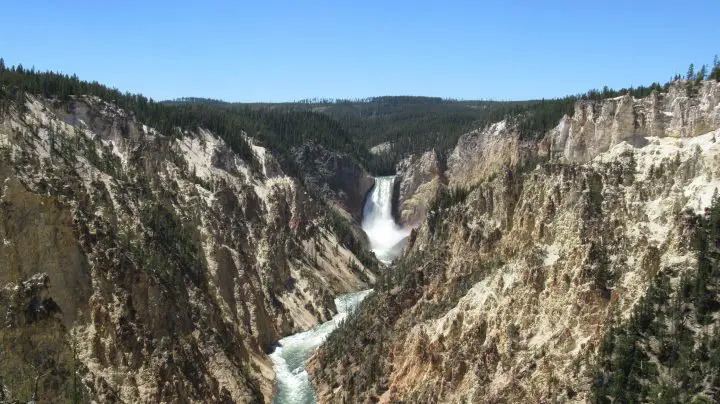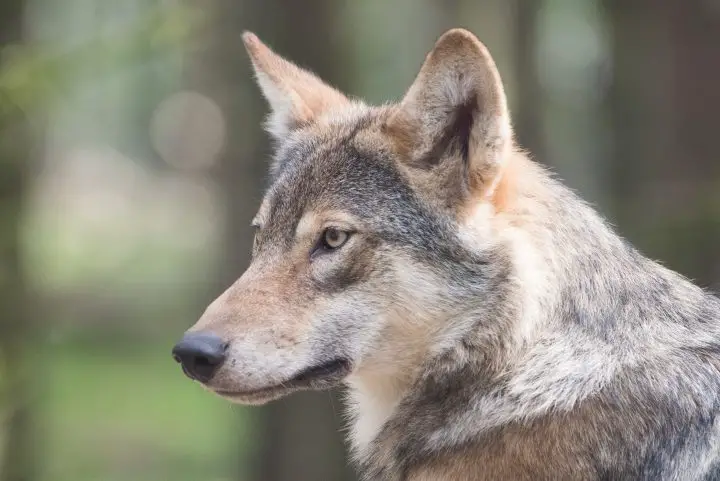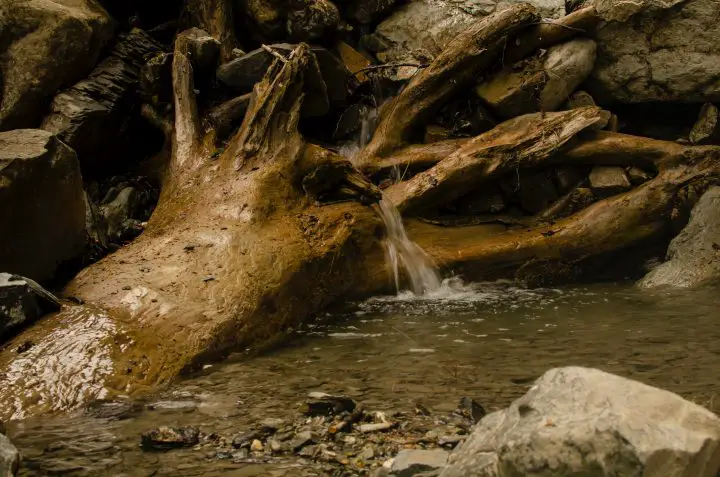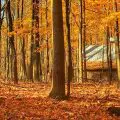Hey! This site is reader-supported and we earn commissions if you purchase products from retailers after clicking on a link from our site.
A visit to Yellowstone National Park is on most traveler’s bucket lists. Aside from the awe-inspiring geysers and hot springs or snapping pictures of grizzlies, there are so many attractions that await. Yet, there are parts that are more frequented than others, which means that many visitors are missing out on marvels. Take for instance the Tower Roosevelt area of Yellowstone, where gorgeous nature and wildlife await.
Whether you are hiking around Old Faithful or plan on driving the Grand Loop, a trip to Tower Roosevelt, Yellowstone is something you shouldn’t miss out on.
Table of Contents
- What is Tower Roosevelt?
- Where Can I Find Roosevelt in Yellowstone?
- What to Do Around Tower Roosevelt
- 1. Head to Tower Fall
- 2. View the Yellowstone River
- 3. Visit Lamar Valley Wildlife
- 4. Look at an Old Ranch
- 5. Eat Like The Pioneers Did
- 6. Visit the Bannock Trail
- 7. Head to Cooke City Museum
- 8. Take the Slough Creek Trail
- 9. Stay at the Roosevelt Lodge
- 10. Petrified Trees, Anyone?
- 11. Do a Mount Washburn Hike
- 12. Challenge Your Car on the Blacktail Plateau Drive
- Ready For a Tower Roosevelt Road Trip?
- FAQs
What is Tower Roosevelt?
Roosevelt is an area with history. The region was frequented by prolific hunter Teddy Roosevelt, who loved both the sprawling beauty but also the abundance of wildlife. In fact, there is a large black bear population that continues to thrive here. Other animals, like grizzly bears, wolves, elk, deer, and moose can also be found in the Tower-Roosevelt area. It’s not uncommon to see bighorns and their lambs along the river’s edge, too.
Where Can I Find Roosevelt in Yellowstone?
The Roosevelt-Tower area is found in the northeast of the park, where the mountains roll endlessly and the land is speckled with fir, spruce, and aspen trees. The Yellowstone River cuts through the area, creating the Tower Fall region, as well as canyon cliffs that plummet into the churning waters below.
The Tower Roosevelt area is surrounded by many other famous attractions and things to do in Yellowstone. Such as Prospect Peak, Mount Washburn, Yellowstone River Overlook, Calcite Springs Overlook, and the Roosevelt Lodge.
What to Do Around Tower Roosevelt
Wondering if a trip to Tower Roosevelt is worth your time and gas? Of course it is. Be sure to bring a picnic basket, comfortable hiking boots, and some sunscreen, because you’re going to be getting in and out of the car all day long.
Here is a list of things to do around Tower Roosevelt, Yellowstone:
1. Head to Tower Fall
The MVP of any trip to the Tower Roosevelt region is Tower Fall. The striking visual of a 132-foot tall waterfall cascading from rocky heights is astounding. Some of the earliest visitors of Yellowstone documented their wonder when finding Tower Fall. Thomas Moran, an artist from the 19th century, also fell in love with the falls. In fact, his painting inspired the birth of Yellowstone National Park.
Since you can find a general store nearby with snacks, why not set up a picnic blanket near Tower Fall and enjoy the majesty of it for a time? The area is frequented by travelers, but the roar of the waterfall is nothing but serenity.

2. View the Yellowstone River
There are a couple of overlooks situated near Tower Fall that offer amazing views. Visit the Calcite Springs overlook, which makes the downstream end of the river. There, you can see some of the scenery that inspired Thomas Moran. Look to the columns of basalt rock and the scars left by ancient volcanic activity.
The overlooks are also excellent sites for bird-watching. You are bound to see osprey and red-tailed hawks soaring through the skies. Near the Yellowstone River Picnic Area, you can also access a trail. At the end, you get a closer look at the river’s terminus.
3. Visit Lamar Valley Wildlife
One of the many splendors of Yellowstone National Park is the wildlife. Anyone who loves witnessing nature in motions should find themselves touring Roosevelt in Yellowstone sooner than later. The Lamar Valley, in particular, is the ideal spot to watch wildlife.
During summer, Lamar Valley is a hotspot for predators like wolves and bears, as well as herds of elk and bison. You can see animals even when it has snowed. Be sure to bring your camera, and keep your eyes open.

Also, remember that if you decide to hike around Lamar Valley, to never approach a wild animal. If you see a bear and wolves, don’t move within 100 yards (91 m) of them. Keep at least 25 yards (23 m) away from all other animals. Otherwise, you could be attacked and injured.
4. Look at an Old Ranch
Visit the Lamar Buffalo Ranch to see some of the history of Yellowstone bison. Until the 1950s, the ranch was operational, part of an effort to increase the bison population. There are four remaining buildings that you can visit as part of the Lamar Buffalo Ranch Historic District, which is registered on the National Register of Historic Places.
In the spring and fall, Expedition Yellowstone, the residential environmental program, uses the ranch for studying. You are more than welcome to stop by and walk around the outside, but the facilities aren’t open to the general public.
5. Eat Like The Pioneers Did
Back when Wyoming was considered the Wild West, an area known as Pleasant Valley was home to Uncle John Yancey’s Pleasant Valley Hotel. It was one of the earliest hotels to be built in Yellowstone. Between 1884 and 1893, the hotel and several outbuildings were constructed. Early visitors to Yellowstone, as well as miners and laborers from Cooke City, used the hotel often.
Unfortunately, none of the original buildings remain. However, you can visit and learn about the hotel while enjoying an Old West Cookout. A horse-drawn wagon will pick you and your friends up to deliver you to the cook site. There, you can feast like the cowboys did.
6. Visit the Bannock Trail
Once, Yellowstone belonged to the Native Americans. There are still traces of their passage throughout Tower Roosevelt, Yellowstone. One of those is the Bannock Trail.
In the past, the natives journeyed from the Snake River in Idaho, down the Bannock Trail, to find the buffalo plains in Wyoming. Between 1840-1876, the trail was used extensively.
These days, you can follow the path along the Blacktail Plateau to the Bannock Ford. You can cross the creek and keep heading toward the Lamar River. The path splits at Soda Butte Creek. There is plenty of signage to guide you along the way.
7. Head to Cooke City Museum
Want to know about the history of the area? Make a pit stop at the quaint Cooke City Museum. Cooke City is a mountain town within the Tower Roosevelt area. There are a few streets, stores, and restaurants to explore, including the museum, which has indoor and outdoor exhibits. You can learn a little about the history of the town and Yellowstone. Afterwards, stop at the local cafe for a cup or two of coffee.
If you’re just entering the area and have never been to the national park, this might be an excellent introduction.
8. Take the Slough Creek Trail
While traveling around Tower Roosevelt, Yellowstone, you will undoubtedly come across the Slough Creek campground. It’s located around 10 miles from Tower Junction. Drive about 2 miles down the gravel round at the campground, and you will come to a parking lot for the Slough Creek Trail.
The trail connects to points like the Buffalo Fork Trail, McBride Lake (where you can wade about and fish), Bliss Pass Trail Junction, and the park’s boundary. Walking the trail takes you along a historic wagon road that travels into the Absaroka Beartooth Wilderness beyond.
It’s about 20.2 miles from start to finish (round trip) and is rated moderate. Some sections are pretty steep, so it’s recommended that you bring the appropriate gear. Also, keep your eyes peeled for moose and bears.
9. Stay at the Roosevelt Lodge
Looking for a budget-friendly stay at Yellowstone? The Roosevelt Lodge is one of the cheapest accommodations you can find around the park, but it’s not because it’s in the Tower Roosevelt region. Rather, it’s because the cabins are very tiny and you have to use a communal bathroom. There is also no A/C in the summer, only wood burning stoves for winter.
But if you plan on using the cabin only for sleeping, the facilities are kept sparkling clean and aren’t very busy. Plus, you’re close to where wolves and bears are regularly food. Get up early enough in the morning for a quick hike, and you’re almost guaranteed to see some kind of wildlife.
If you’re not looking to stay but would like some nourishment, check out the dining room. It’s a step back in time with offerings like wild game chili, baked beans, and more.
10. Petrified Trees, Anyone?
Have you ever seen a petrified tree? Up close, the wood looks like a precious gemstone and feels just as hard. Don’t underestimate how incredible it would be to look upon the world’s largest concentration of petrified trees at Specimen Ridge. There are some samples of petrified trees that don’t exist in this area, too.
If you are feeling daring, why not take a hike through the Tower Roosevelt area via the Specimen Ridge Trail. Open from January to September, this moderately difficult trail draws plenty of hikers and horseback riders. The length is around 16.9 miles, and there is an elevation gain of 3,891 feet. You see the petrified trees, hot springs, and so much more.

11. Do a Mount Washburn Hike
After stopping by Tower Fall and getting invigorated by the sights, you might want to attempt climbing to the top of Mount Washburn. This isn’t an easy hike, so come prepared with your hiking clothes, comfortable shoes, and some hydration, at the very least. While the hike to the top of the mountain and back is only 6 miles in total, the whole trek to the top is on a continuous slope with few breaks.
Luckily, the view from the top is spectacular. You get an unobstructed view of the park spreading out all around you. Plus, you get to feel a sense of achievement having climbed to an elevation of 10,243 feet (3,122 m).
Here’s a fun fact for you: Mount Washburn is a remnant of prehistoric volcanic events that occurred around 45-50 million years ago. Many of the outcrops and rock formations you see in the area, including those around Tower Fall and the Absaroka Range, were formed during that time.
12. Challenge Your Car on the Blacktail Plateau Drive
Maybe you would rather bike or drive out towards the famous Bannock Trail. The Blacktail Plateau Drive goes one way and takes you along a 6-mile scenic route. There is a great chance you will see some wildlife, so keep your eyes open. Yes, the road is a little rough, and there are plenty of potholes to dodge, too. You will want to unhook your fifth wheel or skip the RV for this one.
Ready For a Tower Roosevelt Road Trip?
Now that you know about Tower Roosevelt in Yellowstone, you’re probably itching to go. There is so much to do in the area, including bird-watching, horseback riding, hiking, and camping. So don’t just stop at the geysers and move on. Check out the historic trails, eat like a cowboy, and see what kept bringing Roosevelt back for more.
FAQs
Where is the Roosevelt area in Yellowstone?
Roosevelt is located in the northeast corner of Yellowstone National Park. Not only can you see Tower Fall at this location, but there is a large population of wildlife to be seen, too.



